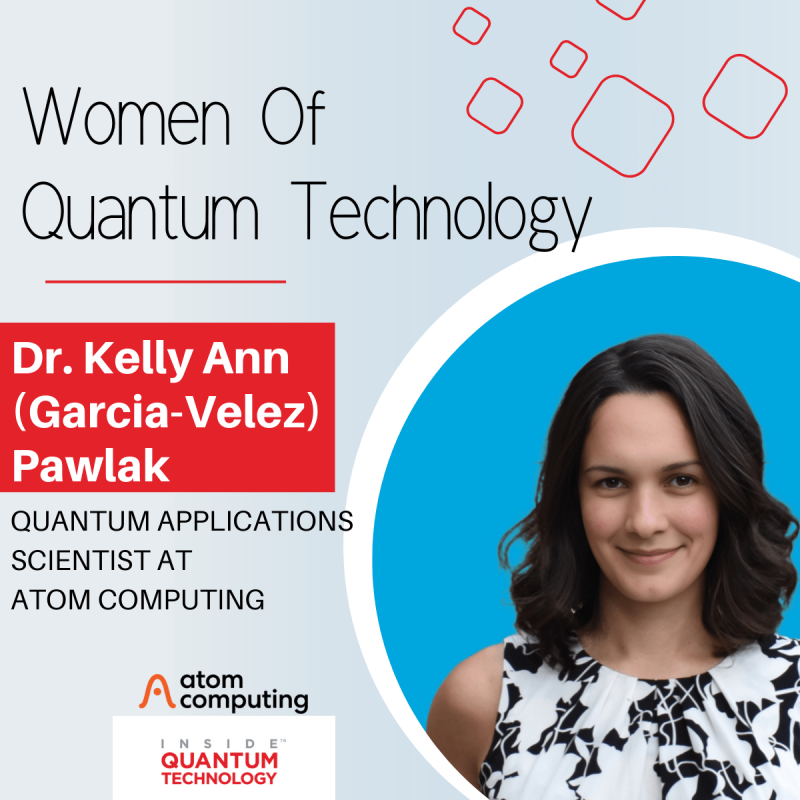Women of Quantum Technology: Kelly Ann Pawlak of Atom Computing

There was a distinctive moment when Dr. Kelly Ann Pawlak, a Quantum Applications Engineer at quantum computing company Atom Computing, became interested in quantum physics. “I was in seventh grade,” she explained. “And my math teacher brought in this video called The Elegant Universe by Brian Greene.” Over the period of two days, Pawlak’s class watched this documentary, and as Pawlak stated, “It just sort of blew my mind. At that moment, I knew that I wanted to be a physicist.”
Through high school, Pawlak satiated her love of physics, buying math books and other physics books with her school outfit allowance. However, once Pawlak reached college, her confidence in the field wavered. “Funny enough, when I went to college, I didn’t think I was skilled enough to seriously study physics, and I didn’t see anyone like me studying it” she stated. “So, I actually changed majors, quite a few times. I didn’t feel like I was good enough at math. I started with just sort of exploring, and I ended up doing chemistry.” While in chemistry, Pawlak worked in a photochemistry lab and was exposed to formal quantum mechanics. She found that she enjoyed the mathematics side of it. Eventually, she gave in to her curiosity and double majored in both physics and mathematics. “I ended up going to grad school for condensed matter physics after that,” Pawlak added. “And I sort of fell in love with all of the theories of quantum, like how every crystalline material holds a secret universe with its own laws and particles, and working with the mathematics of it.”
Ironically, during graduate school, Pawlak didn’t cultivate an interest in quantum computing. As she explained, “I thought quantum computing was boring. I went to a few talks, and it just didn’t stick with me, I didn’t understand the point. Then during my third year of grad school, Chris Monroe came and gave a seminar. And he gave this talk on his ion trap computer before it was IonQ, and showed that you could use quantum computers to simulate very real material physics and spin systems. Instantly, everything about quantum computing just sort of clicked for me.” Pawlak was immediately hooked. “So, I became very interested in just this idea that quantum computers could be better quantum simulators.” She pondered this idea during her Ph.D. program, and eventually graduated with her Ph.D. in condensed matter and statistical physics from the University of California Santa Barbara.”
Moving to Atom Computing
Though Pawlak had a passion for quantum physics and mathematics, by the end of the program she knew she didn’t want to be a professor in either of those fields. Instead, she began looking at the industry side of quantum and math, wondering what sorts of positions could be open to her. “I did a lot of self-study to learn about quantum computing, especially the applications side of it, where you’re applying the quantum computer to real-world scientific and industrial problems,” she added. “I got really excited about that. And I just started applying to quantum computing industry jobs.” While her first industry position was at ColdQuanta, now Infleqtion, Pawlak quickly transitioned to her current position at Atom Computing.
Now as a Quantum Applications Engineer at Atom Computing, Pawlak gets to use her creativity and love of quantum physics to dive into possible use cases for the quantum computer. “I’m basically coming up with ways to apply the device to real-world problems,” she stated. “Whether that is an industrial use case that a company is interested in, or, advancing science by figuring out how to use the device in the best way possible to model some material. My current job is this really fun balance of research and algorithms.” To do this, Pawlak looks into what sorts of algorithms will be implemented in a particular use case, sometimes using handwritten equations to walk through the math. “So, I’ve been working on algorithms that can take advantage of the special capabilities of our machine, because you can’t just take a superconducting qubit algorithm and apply it to a neutral atom quantum computer with great results,” Pawlak elaborated. “So I’d say like 50% of my day-to-day is just coming up with these novel algorithms and interesting ways to use the device, which is very fun.” When she’s not looking at algorithms, Pawlak is usually discussing quantum computing with other researchers at Atom Computing. As she explained, “The other half of my job is actually working with people externally, who are doing their own research and helping them understand how to think about our device; like how to actually run those applications and doing coding work.”
Being one of the women within the heavily male-dominated field of quantum physics, Pawlak understands the importance of making the industry and community more inclusive. “I’ve had some harrowing experiences in my career,” she stated. “And something I always come back to is that the only way to heal this industry and a lot of STEM industries, in general, is to just have more women present. Some of my worst experiences have been in graduate school. I was one of two women theorists in my year, maybe four or five in the entire program, out of over 100 graduate students. It’s the absolute isolation of those numbers. It is so intimidating and it makes it difficult to even express yourself, or raise issues. So just increasing the number of women and underrepresented minorities as a baseline is probably going to be the fastest way to rapidly improve equity in the near-term.”
However, to get a higher number of women in this industry, it will not be easy. “There are challenges to that because we have this leaky pipeline since women are still so poorly represented in physics,” Pawlak explained. “A lot of women just don’t feel comfortable finishing their degree, or get boxed out in the process. And, these women are fully capable of finishing their degree, but then it’s not on their resume, so they may be totally shut out from jobs for not having certain qualifications.” As Pawlak added, it means that many qualified candidates may be avoided due to their educational history, which may not reflect the whole story. “It’s a very complex problem,” she said. “But we need to figure out just how to increase diversity in the field a priori, and really bootstrap those effects.”
Kenna Hughes-Castleberry is a staff writer at Inside Quantum Technology and the Science Communicator at JILA (a partnership between the University of Colorado Boulder and NIST). Her writing beats include deep tech, quantum computing, and AI. Her work has been featured in Scientific American, New Scientist, Discover Magazine, Ars Technica, and more.



















